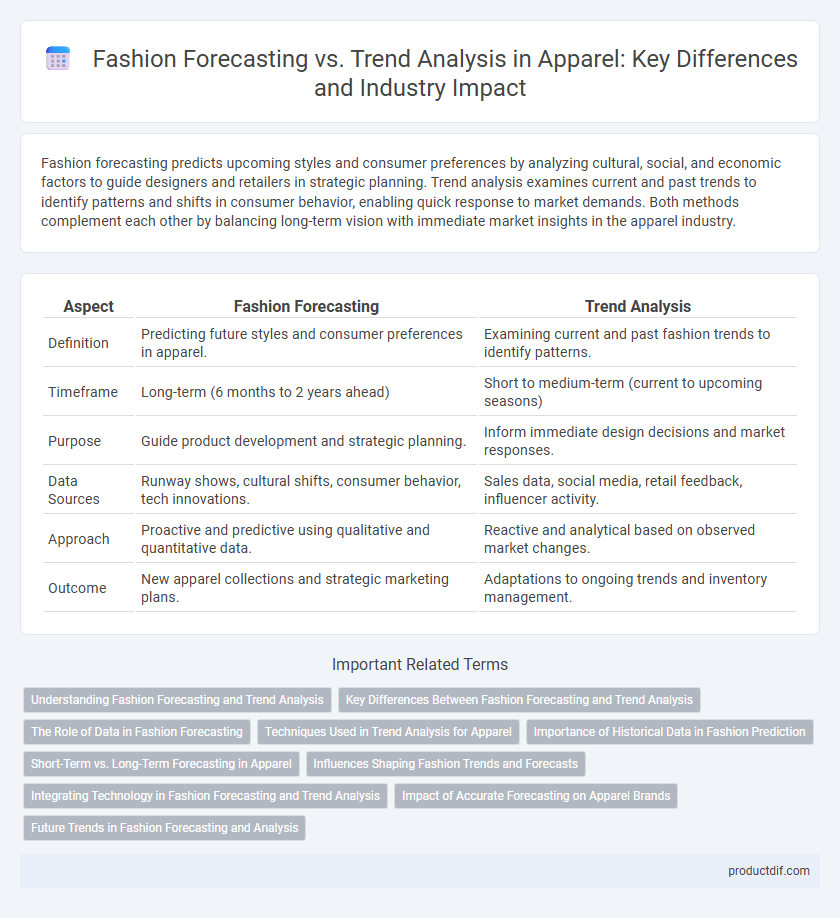Fashion forecasting predicts upcoming styles and consumer preferences by analyzing cultural, social, and economic factors to guide designers and retailers in strategic planning. Trend analysis examines current and past trends to identify patterns and shifts in consumer behavior, enabling quick response to market demands. Both methods complement each other by balancing long-term vision with immediate market insights in the apparel industry.
Table of Comparison
| Aspect | Fashion Forecasting | Trend Analysis |
|---|---|---|
| Definition | Predicting future styles and consumer preferences in apparel. | Examining current and past fashion trends to identify patterns. |
| Timeframe | Long-term (6 months to 2 years ahead) | Short to medium-term (current to upcoming seasons) |
| Purpose | Guide product development and strategic planning. | Inform immediate design decisions and market responses. |
| Data Sources | Runway shows, cultural shifts, consumer behavior, tech innovations. | Sales data, social media, retail feedback, influencer activity. |
| Approach | Proactive and predictive using qualitative and quantitative data. | Reactive and analytical based on observed market changes. |
| Outcome | New apparel collections and strategic marketing plans. | Adaptations to ongoing trends and inventory management. |
Understanding Fashion Forecasting and Trend Analysis
Fashion forecasting involves predicting upcoming styles, colors, and consumer preferences months or even years ahead to guide design and inventory decisions. Trend analysis examines current and past market patterns, consumer behavior, and runway looks to identify emerging trends in real time. Understanding both techniques enables apparel brands to stay competitive by balancing long-term innovation with immediate market demands.
Key Differences Between Fashion Forecasting and Trend Analysis
Fashion forecasting predicts future apparel styles and consumer preferences by analyzing emerging cultural, social, and economic signals, while trend analysis examines current and past fashion trends to understand their evolution and impact. Forecasting relies on extensive data from runway shows, street styles, and market research to anticipate long-term shifts, whereas trend analysis focuses on short-term patterns and their immediate influence on consumer buying behavior. The key difference lies in forecasting's forward-looking approach versus trend analysis's retrospective evaluation, both essential for strategic decision-making in the apparel industry.
The Role of Data in Fashion Forecasting
Fashion forecasting relies heavily on data analytics to predict future consumer preferences, using historical sales, social media trends, and market research to anticipate upcoming styles. Trend analysis focuses on interpreting current and past fashion movements, drawing insights from runway shows, streetwear, and celebrity influence to identify patterns. Data plays a crucial role in fashion forecasting by enabling designers and brands to make informed decisions that align with evolving market demands and reduce financial risks.
Techniques Used in Trend Analysis for Apparel
Trend analysis in apparel utilizes techniques such as data mining, consumer behavior studies, and social media monitoring to identify emerging styles and preferences. Visual merchandising and runway reviews provide qualitative insights, while sales data and market research offer quantitative support for forecasting demand. These methods collectively enable brands to predict and adapt to fashion trends effectively.
Importance of Historical Data in Fashion Prediction
Historical data plays a crucial role in fashion forecasting by allowing designers and retailers to identify recurring patterns and consumer preferences over time. This information enhances trend analysis accuracy, enabling brands to anticipate seasonal demands and optimize inventory management. Leveraging past sales figures, fabric popularity, and style cycles ensures more informed, strategic decisions in the ever-evolving apparel industry.
Short-Term vs. Long-Term Forecasting in Apparel
Fashion forecasting in apparel involves predicting long-term consumer preferences and industry shifts over multiple seasons, helping brands plan collections years in advance. Trend analysis focuses on short-term changes, capturing immediate shifts in styles, colors, and fabrics that influence upcoming seasons or months. Combining both approaches enables apparel companies to balance innovation with market responsiveness, optimizing inventory and design strategies.
Influences Shaping Fashion Trends and Forecasts
Fashion forecasting harnesses consumer behavior data, cultural movements, and technological innovations to predict future apparel trends, while trend analysis examines past and current market patterns to understand style evolution. Influences shaping fashion trends and forecasts include social media impact, global street style, and sustainability concerns driving fabric choices and color palettes. Retail analytics and designer collaborations further refine predictions, enabling brands to align collections with anticipated consumer demands.
Integrating Technology in Fashion Forecasting and Trend Analysis
Fashion forecasting and trend analysis increasingly rely on advanced technologies such as AI-driven data analytics and machine learning algorithms to predict consumer preferences and emerging styles with greater accuracy. Integration of big data from social media, e-commerce platforms, and global market trends enables real-time insights that enhance decision-making in apparel design and merchandising. This technological convergence allows brands to proactively adapt to market shifts, optimize inventory management, and create personalized fashion experiences.
Impact of Accurate Forecasting on Apparel Brands
Accurate fashion forecasting enables apparel brands to anticipate consumer preferences, optimize inventory, and reduce waste, directly impacting profitability. Trend analysis identifies current styles, while forecasting predicts future demands, allowing brands to allocate resources strategically and stay competitive. Effective forecasting enhances product relevance and strengthens brand loyalty by aligning with evolving market dynamics.
Future Trends in Fashion Forecasting and Analysis
Fashion forecasting utilizes data-driven insights and consumer behavior patterns to predict upcoming styles months or years in advance, enabling apparel brands to strategically plan collections and inventory. Trend analysis focuses on interpreting current market movements and cultural shifts to identify short-term popular aesthetics, often reacting to immediate consumer demands. Integrating both approaches allows designers and retailers to anticipate future demands while adapting to evolving fashion landscapes, optimizing product relevance and competitive advantage.
Fashion forecasting vs Trend analysis Infographic

 productdif.com
productdif.com